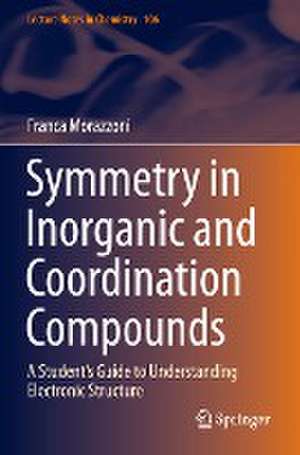Symmetry in Inorganic and Coordination Compounds: A Student's Guide to Understanding Electronic Structure: Lecture Notes in Chemistry, cartea 106
Autor Franca Morazzonien Limba Engleză Paperback – 29 apr 2022
Adapted from university lecture course notes, this book is the ideal companion for any inorganic chemistry course dealing with group theory.
| Toate formatele și edițiile | Preț | Express |
|---|---|---|
| Paperback (1) | 776.72 lei 6-8 săpt. | |
| Springer International Publishing – 29 apr 2022 | 776.72 lei 6-8 săpt. | |
| Hardback (1) | 947.35 lei 3-5 săpt. | |
| Springer International Publishing – 29 apr 2021 | 947.35 lei 3-5 săpt. |
Din seria Lecture Notes in Chemistry
-
 Preț: 96.74 lei
Preț: 96.74 lei - 18%
 Preț: 1123.35 lei
Preț: 1123.35 lei - 18%
 Preț: 779.57 lei
Preț: 779.57 lei - 18%
 Preț: 1005.74 lei
Preț: 1005.74 lei - 18%
 Preț: 997.88 lei
Preț: 997.88 lei - 18%
 Preț: 1004.00 lei
Preț: 1004.00 lei - 18%
 Preț: 1136.30 lei
Preț: 1136.30 lei - 18%
 Preț: 1117.03 lei
Preț: 1117.03 lei - 18%
 Preț: 1006.55 lei
Preț: 1006.55 lei - 18%
 Preț: 903.62 lei
Preț: 903.62 lei -
 Preț: 377.73 lei
Preț: 377.73 lei -
 Preț: 395.63 lei
Preț: 395.63 lei - 18%
 Preț: 728.43 lei
Preț: 728.43 lei - 18%
 Preț: 782.57 lei
Preț: 782.57 lei - 18%
 Preț: 1112.78 lei
Preț: 1112.78 lei - 15%
 Preț: 688.13 lei
Preț: 688.13 lei - 15%
 Preț: 646.62 lei
Preț: 646.62 lei -
 Preț: 393.35 lei
Preț: 393.35 lei - 18%
 Preț: 1124.30 lei
Preț: 1124.30 lei -
 Preț: 384.86 lei
Preț: 384.86 lei -
 Preț: 383.71 lei
Preț: 383.71 lei -
 Preț: 378.71 lei
Preț: 378.71 lei -
 Preț: 384.09 lei
Preț: 384.09 lei -
 Preț: 387.42 lei
Preț: 387.42 lei -
 Preț: 388.90 lei
Preț: 388.90 lei -
 Preț: 393.35 lei
Preț: 393.35 lei -
 Preț: 384.09 lei
Preț: 384.09 lei -
 Preț: 377.73 lei
Preț: 377.73 lei -
 Preț: 382.95 lei
Preț: 382.95 lei -
 Preț: 384.70 lei
Preț: 384.70 lei - 15%
 Preț: 644.63 lei
Preț: 644.63 lei -
 Preț: 386.00 lei
Preț: 386.00 lei -
 Preț: 389.70 lei
Preț: 389.70 lei -
 Preț: 384.09 lei
Preț: 384.09 lei -
 Preț: 385.25 lei
Preț: 385.25 lei -
 Preț: 392.21 lei
Preț: 392.21 lei -
 Preț: 386.00 lei
Preț: 386.00 lei -
 Preț: 403.37 lei
Preț: 403.37 lei -
 Preț: 378.71 lei
Preț: 378.71 lei -
 Preț: 383.50 lei
Preț: 383.50 lei -
 Preț: 390.63 lei
Preț: 390.63 lei -
 Preț: 389.31 lei
Preț: 389.31 lei
Preț: 776.72 lei
Preț vechi: 947.22 lei
-18% Nou
Puncte Express: 1165
Preț estimativ în valută:
148.64€ • 161.40$ • 124.86£
148.64€ • 161.40$ • 124.86£
Carte tipărită la comandă
Livrare economică 22 aprilie-06 mai
Preluare comenzi: 021 569.72.76
Specificații
ISBN-13: 9783030629984
ISBN-10: 3030629988
Ilustrații: XVII, 185 p. 181 illus., 13 illus. in color.
Dimensiuni: 155 x 235 mm
Greutate: 0.29 kg
Ediția:1st ed. 2021
Editura: Springer International Publishing
Colecția Springer
Seria Lecture Notes in Chemistry
Locul publicării:Cham, Switzerland
ISBN-10: 3030629988
Ilustrații: XVII, 185 p. 181 illus., 13 illus. in color.
Dimensiuni: 155 x 235 mm
Greutate: 0.29 kg
Ediția:1st ed. 2021
Editura: Springer International Publishing
Colecția Springer
Seria Lecture Notes in Chemistry
Locul publicării:Cham, Switzerland
Cuprins
The electronic structure determination and its symmetry aspects.- Symmetry orbitals for different di- and poly-atomic molecules.- Perturbation theory.- Magnetism.- Use of symmetry properties to describe the electronic structure of coordination compounds and minerals.
Notă biografică
Prof. Franca Morazzoni earned her Ph.D. in chemistry at the University of Milano, becoming Associate Professor then Full Professor of Inorganic Chemistry at the University of Milano-Bicocca where she founded the group of hybrid nanomaterials in the Department of Materials Science in 2001. As an expert in physical methods in inorganic chemistry applied to hybrid materials, she has published more than 250 peer-reviewed papers in international journals. She has been responsible for leading several national research projects in the field, participating, most notably, in the development of novel inorganic nanofillers with controlled shapes in industrial collaboration with Pirelli Tyres, based in Milan, resulting in several patents on this topic. She was Vice Chair of the HINT COST action (2012–2016) on the topic of organic–inorganic hybrid interfaces. Prof. Morazzoni has supervised several Ph.D. students and, until 2015, was Director of the PhD School of the University of Milano-Bicocca.
Textul de pe ultima copertă
This book addresses the nature of the chemical bond in inorganic and coordination compounds. In particular, it explains how general symmetry rules can describe chemical bond of simple inorganic molecules. Since the complexity of studying even simple molecules requires approximate methods, this book introduces a quantum mechanical treatment taking into account the geometric peculiarities of the chemical compound. In the case of inorganic molecules, a convenient approximation comes from symmetry, which constrains both the electronic energies and the chemical bonds. The book also gives special emphasis on symmetry rules and compares the use of symmetry operators with that of Hamiltonian operators. Where possible, the reactivity of molecules is also rationalized in terms of these symmetry properties. As practical examples, electronic spectroscopy and magnetism give experimental confirmation of the predicted electronic energy levels.
Adapted from university lecture course notes, this book is the ideal companion for any inorganic chemistry course dealing with group theory.
Adapted from university lecture course notes, this book is the ideal companion for any inorganic chemistry course dealing with group theory.
Caracteristici
Describes and compares chemical bonding in inorganic and coordination compounds using variation and perturbation methods Shows how general symmetry rules can describe the chemical bond of even simple inorganic molecules Provides a simple guide for students to use crystal field theory to understand electronic and magnetic spectra
